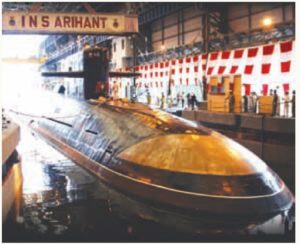2016-10-28 According to an article by Vishal Thapar published by our partner India Strategic, India has moved closer to having a nuclear triad.
New Delhi. India has moved a step closer to achieving the triad of nuclear weapons with the induction of its first ballistic missile firing nuclear-powered submarine (SSBN), Arihant, in the Strategic Forces Command (SFC) in August this year.
There is no official confirmation but indications are that Arihant was quietly commissioned in August in the presence of some top officials, including Chief of Naval Staff Admiral Sunil Lanba in Vishakhapatnam.
The Navy has declined comment as the country’s nuclear assets are managed by SFC under the direct control of the Prime Minister’s Office (PMO).
The tri-Service SFC is the custodian of both the nuclear arsenal and delivery systems.
There is no word yet on whether or not Arihant has commenced operational deterrence patrols but the indication is yes, this is so, as several firing tests have reportedly been conducted successfully over the past few months.

The Arihant – Sanskrit for annihilator of enemies – is the first of the three SSBNs, which will provide the beginnings for underwater nuclear deterrence for India.
The second of the Arihant class, Aridhaman is reported to be in an advanced stage of construction at the Ship Building Centre in Vizag, and slated to be handed over for sea trials in 2018.
Work on the third SSBN submarine is going on simultaneously but details are not available.
The induction of the Arihant suggests that the sea trials, which commenced in December 2014, are complete, technologies validated, and the Navy-led arm of the SFC has accepted the submarine.
It is armed with the K and B series of nuclear-tipped ballistic missiles. The K-15 and K-4 missiles have ranges of 750 and 3,500 km respectively. The K-series of missiles have been named after the father of India’s ballistic missile program, Dr. APJ Abdul Kalam, while the B series is reportedly named after Vice Admiral Promod Bhasin who worked on the early years of project development.
The Arihant class submarines and their missiles add teeth and credibility to India’s nuclear deterrence program.
Submarine-launched ballistic missile firing capability ensures maximum survivability for a country’s nuclear arsenal in the face of a decapitating first strike by an adversary, lending credibility to a second-strike capability, which is at the heart of India’s doctrine of No First Use.
It is, hence, considered the most reliable leg of the nuclear triad.
The SSBN allows India to deploy its nuclear weapons under water thousands of miles away from its shores for extended periods of time. Arihant’s 83 MW pressurized water reactor allows prolonged submergence without the need to surface, ensuring stealth and extended reach. The period of submergence is limited only by the human endurance of the crew.
Nicknamed the ‘Baby Boomer’ in global strategic chatter, the 6,000-tonne Arihant is the world’s smallest SSBN.
The Advanced Technology Vessel (ATV) project to build SSBN’s for India’s nuclear deterrence was conceived in the 1970s but actually got off the ground in the early 2000s following the strategic re-engagement between India and Russia during the tenure of AB Vajpayee as Prime Minister.
India has acknowledged significant Russian assistance for the project, particularly in respect of miniaturizing the reactor. The Indian private sector has also played a leading role, both in building the pressurized hull and other critical sub-systems for the strategic submarines.
It has taken seven long years for the induction of the Arihant after the high-profile launch of this submarine by the then Prime Minister Manmohan Singh on July 26, 2009. The long lead-in time for induction is a reflection of multiple technical glitches and project delays. The reactor turned critical in August 2013 and sea trials started in December 2014.
Besides SSBNs, India has also embarked on a project to make a fleet of nuclear-powered, conventionally armed attack submarines.
Early-2015, the 30-year submarine building plan was modified to make a provision for the construction of six such SSNs. This was flagged off by the Cabinet Committee on Security.
INS Chakra, an Akula-class SSN leased from Russia for 10 years in 2012 is meant to help India prepare to operate nuclear powered vessels. The K-series of submarine-launched ballistic missiles (SLBMs) have also been successfully test-fired.

There are plans also to lease a second Akula class submarine from Russia. If this matures, then it will be fitted with the Indo-Russian supersonic 300-km range Brahmos missile, as shown in the official illustration above.
http://www.indiastrategic.in/2016/10/19/india-inducts-first-ssbn-step-closer-to-n-triad/

